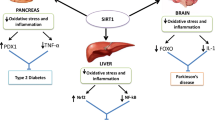Abstract
Increasing evidence has shown that pseudogenes can widely regulate gene expression. However, little is known about the specific role of PTENP1 and miR-499-5p in insulin resistance. The relative transcription level of PTENP1 was examined in db/db mice and high fat diet (HFD)-fed mice by real-time PCR. To explore the effect of PTENP1 on insulin resistance, adenovirus overexpressing or inhibiting vectors were injected through the tail vein. Bioinformatics predictions and a luciferase reporter assay were used to explore the interaction between PTENP1 and miR-499-5p. The relative transcription level of PTENP1 was largely enhanced in db/db mice and HFD-fed mice. Furthermore, the overexpression of PTENP1 resulted in impaired Akt/GSK activation as well as glycogen synthesis, while PTENP1 inhibition led to the improved activation of Akt/GSK and enhanced glycogen contents. More importantly, PTENP1 could directly bind miR-499-5p, thereby becoming a sink for miR-499-5p. PTENP1 overexpression results in the impairment of the insulin-signaling pathway and may function as a competing endogenous RNA for miR-499-5p, thereby contributing to insulin resistance.
Similar content being viewed by others
Abbreviations
- ceRNA:
-
competing endogenous RNA
- db/db mouse:
-
mouse with db/db mutation, a model for diabetic dyslipidemia
- GFP:
-
green fluorescent protein
- GTT:
-
glucose tolerance test
- HFD:
-
high fat diet
- ITT:
-
insulin tolerance test
- lncRNAs:
-
long noncoding RNAs
- miRNA (miR):
-
microRNAs
- PTENP1:
-
phosphatase and tensin homolog pseudogene 1
- 3′-UTR:
-
3′-untranslated region
- WT:
-
wild-type
References
Frampton, A. E., Krell, J., Jamieson, N. B., Gall, T. M., Giovannetti, E., Funel, N., Mato Prado, M., Krell, D., Habib, N. A., Castellano, L., Jiao, L. R., and Stebbing, J. (2015) MicroRNAs with prognostic significance in pancreatic ductal adenocarcinoma: a meta-analysis, Eur. J. Cancer, 51, 1389–1404.
Zaleska, K. (2015) miRNA–therapeutic tool in breast cancer? Where are we now? Rep. Pract. Oncol. Radiother., 20, 79–86.
Mahdavinezhad, A., Mousavi-Bahar, S. H., Poorolajal, J., Yadegarazari, R., Jafari, M., Shabab, N., and Saidijam, M. (2015) Evaluation of miR-141, miR-200c, miR-30b expression and clinicopathological features of bladder cancer, Int. J. Mol. Cell. Med., 4, 32–39.
Haldrup, C., Kosaka, N., Ochiya, T., Borre, M., Hoyer, S., Orntoft, T. F., and Sorensen, K. D. (2014) Profiling of circulating microRNAs for prostate cancer biomarker discovery, Drug. Deliv. Transl. Res., 4, 19–30.
Prokopi, M., Kousparou, C. A., and Epenetos, A. A. (2014) The secret role of microRNAs in cancer stem cell development and potential therapy: a Notch-pathway approach, Front. Oncol., 4, 389.
Wilusz, J. E., Sunwoo, H., and Spector, D. L. (2009) Long noncoding RNAs: functional surprises from the RNA world, Genes Dev., 23, 1494–1504.
Mercer, T. R., Dinger, M. E., and Mattick, J. S. (2009) Long non-coding RNAs: insights into functions, Nat. Rev. Genet., 10, 155–159.
Poliseno, L., and Pandolfi, P. P. (2015) PTEN ceRNA networks in human cancer, Methods, 77-78, 41–50.
Salmena, L., Poliseno, L., Tay, Y., Kats, L., and Pandolfi, P. P. (2011) A ceRNA hypothesis: the Rosetta Stone of a hidden RNA language? Cell, 146, 353–358.
Cesana, M., Cacchiarelli, D., Legnini, I., Santini, T., Sthandier, O., Chinappi, M., Tramontano, A., and Bozzoni, I. (2011) A long noncoding RNA controls muscle differentiation by functioning as a competing endogenous RNA, Cell, 147, 358–369.
Wang, Y., Xu, Z., Jiang, J., Xu, C., Kang, J., Xiao, L., Wu, M., Xiong, J., Guo, X., and Liu, H. (2013) Endogenous miRNA sponge lincRNA-RoR regulates Oct4, Nanog, and Sox2 in human embryonic stem cell self-renewal, Dev. Cell, 25, 69–80.
Poliseno, L., Salmena, L., Zhang, J., Carver, B., Haveman, W. J., and Pandolfi, P. P. (2010) A coding-independent function of gene and pseudogene mRNAs regulates tumour biology, Nature, 465, 1033–1038.
Fujii, G. H., Morimoto, A. M., Berson, A. E., and Bolen, J. B. (1999) Transcriptional analysis of the PTEN/MMAC1 pseudogene, psiPTEN, Oncogene, 18, 1765–1769.
Wang, L., Zhang, N., Pan, H. P., Wang, Z., and Cao, Z. Y. (2015) MiR-499-5p contributes to hepatic insulin resistance by suppressing PTEN, Cell. Physiol. Biochem., 36, 2357–2365.
Xiao, C., Srinivasan, L., Calado, D. P., Patterson, H. C., Zhang, B., Wang, J., Henderson, J. M., Kutok, J. L., and Rajewsky, K. (2008) Lymphoproliferative disease and autoimmunity in mice with increased miR-17-92 expression in lymphocytes, Nat. Immunol., 9, 405–414.
Harrison, P. M., Zheng, D., Zhang, Z., Carriero, N., and Gerstein, M. (2005) Transcribed processed pseudogenes in the human genome: an intermediate form of expressed retrosequence lacking protein-coding ability, Nucleic Acids Res., 33, 2374–2383.
D’Errico, I., Gadaleta, G., and Saccone, C. (2004) Pseudogenes in metazoa: origin and features, Brief Funct. Genom. Proteom., 3, 157–167.
Pink, R. C., Wicks, K., Caley, D. P., Punch, E. K., Jacobs, L., and Carter, D. R. (2011) Pseudogenes: pseudo-functional or key regulators in health and disease? RNA, 17, 792–798.
Seitz, H. (2009) Redefining microRNA targets, Curr. Biol., 19, 870–873.
Gu, S., Jin, L., Zhang, F., Sarnow, P., and Kay, M. A. (2009) Biological basis for restriction of microRNA targets to the 3'-untranslated region in mammalian mRNAs, Nat. Struct. Mol. Biol., 16, 144–150.
Author information
Authors and Affiliations
Corresponding author
Additional information
Published in Russian in Biokhimiya, 2016, Vol. 81, No. 7, pp. 971-981.
Originally published in Biochemistry (Moscow) On-Line Papers in Press, as Manuscript BM16-029, April 24, 2016.
These authors contributed equally to this work.
To whom correspondence should be addressed.
Rights and permissions
About this article
Cite this article
Wang, L., Zhang, N., Wang, Z. et al. Pseudogene PTENP1 functions as a competing endogenous RNA (ceRNA) to regulate PTEN expression by sponging miR-499-5p. Biochemistry Moscow 81, 739–747 (2016). https://doi.org/10.1134/S0006297916070105
Received:
Revised:
Published:
Issue Date:
DOI: https://doi.org/10.1134/S0006297916070105




